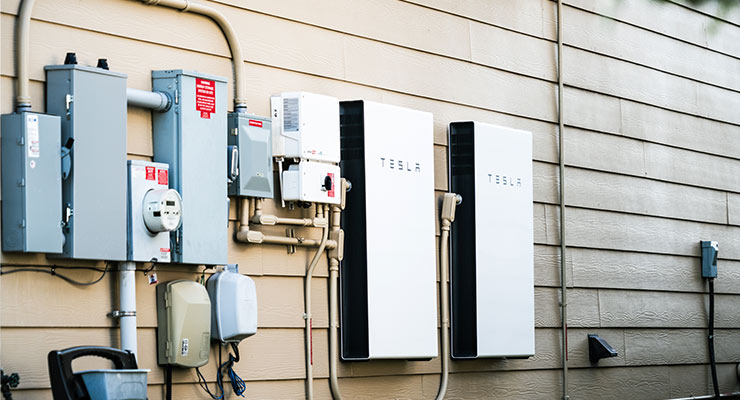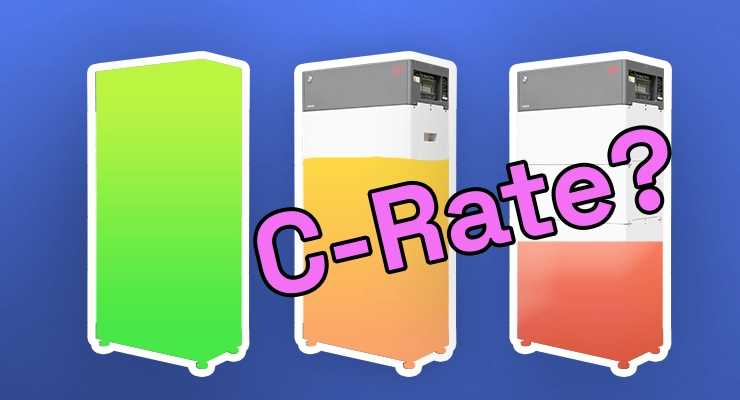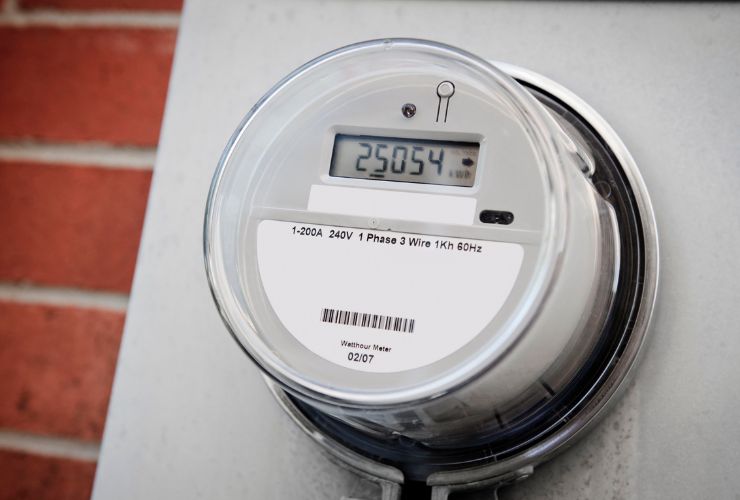Fast read
A battery's C-rate measures how quickly it can be charged or discharged relative to its total capacity. It's a crucial factor for your home energy system because it determines how much power the battery can deliver at once—for example, to start up a high-demand appliance. Understanding the C-rate helps you choose a battery that matches your household's power needs without sacrificing the battery's lifespan.
What is a battery’s “C-rate” and why does it matter?
When navigating the world of solar batteries, you’ll encounter a lot of technical specifications. One of the most important, yet often misunderstood, is the “C-rate”. Getting your head around this single metric is a big step toward choosing the right battery for your home, ensuring it not only stores enough energy but can also deliver the power you need, right when you need it.
What exactly is a battery C-rate?
In simple terms, the C-rate is a measure of the speed at which a battery is charged or discharged. The ‘C’ stands for Capacity, which is typically measured in Amp-hours (Ah). The C-rate tells you how much current can be drawn from the battery relative to that capacity.
Think of it like the size of the pipe coming out of a water tank. A bigger tank (higher capacity) holds more water, but a wider pipe (higher C-rate) lets you get that water out faster.
Here’s a straightforward way to understand the numbers:
- A 1C rating means the battery can be fully discharged in one hour. For a 100Ah battery, a 1C discharge rate would be 100 amps.
- A 2C rating means the battery can be fully discharged in half an hour (30 minutes), delivering twice the current. For that same 100Ah battery, this would be 200 amps.
- A 0.5C rating (or C/2) means it would take two hours to fully discharge. For the 100Ah battery, this would be a 50-amp current.
This rating is crucial because the available energy in most batteries depends on how fast you charge or discharge them.

Why is the C-rate so important for your home?
The C-rate directly impacts your real-world experience with a home battery system. It determines the battery’s ability to respond to your household’s power demands, which can vary significantly throughout the day.
Imagine you’re running your dishwasher and microwave while the air conditioner kicks in. This creates a sudden, high demand for power. A battery with a higher discharge C-rate can handle this surge, delivering a large amount of power instantly to run all those appliances simultaneously. A battery with a lower C-rate might struggle, potentially causing your system to draw expensive power from the grid to meet the shortfall.
For residential solar batteries, C-rates are typically in the range of 0.5C to 1C. This provides a good balance between being able to meet peak household demands and maintaining the long-term health of the battery.
How C-rate affects battery performance and lifespan
There’s a trade-off between power output and longevity. While a high C-rate means more power on demand, it also puts more stress on the battery’s internal components.
- Heat Generation: Charging or discharging at a high C-rate generates more heat. Over time, excessive heat can degrade the battery’s cells, reducing its overall lifespan and capacity.
- Efficiency: Pushing a battery to its C-rate limits can reduce its efficiency, meaning more energy is lost as heat during charging and discharging.
- Cycle Life: The long-term cycle life of a battery is more affected by its charging C-rate than its discharging one. Consistently charging a battery too quickly can cause permanent damage to its internal structure, reducing the total number of cycles it can perform over its lifetime.
Because of this, battery manufacturers specify a recommended C-rate for continuous charging and discharging. Operating within these limits is key to achieving the expected battery performance and lifespan of your investment.
C-rate in practice: Comparing popular battery choices
Different battery chemistries and designs lead to different C-rates. For example, Lithium Iron Phosphate (LFP) batteries, which are common in home storage, are known for their safety and stability and typically have a maximum C-rate of around 1C to 3C.
Let’s look at how this applies to some well-known brands in Australia:
- Tesla Powerwall: The Tesla Powerwall 3, with its 13.5 kWh of usable capacity, offers 11.5 kW of continuous power output, a significant increase from the Powerwall 2’s 5 kW. This higher power output makes it more capable of running a larger number of appliances at once during a grid outage.
- Sungrow SBR Series: A modular battery like the Sungrow SBR can be scaled in size. It has a maximum continuous charge/discharge current of 30A. While this current limit is fixed, adding more battery modules (e.g., scaling from a 12.8kWh to a 19.2kWh setup) increases the system’s total voltage, which in turn increases the overall power output (kW) it can deliver.
- Sigenergy SigenStor: This is an all-in-one system that integrates the inverter and battery modules. The power output is determined by the system’s built-in inverter, not the individual battery modules. For example, a SigenStor system can provide from 3 kW up to 25 kW of power, depending on the model. You can stack battery modules (each 5 kWh or 8 kWh) to increase total energy storage, and its high peak power capabilities are excellent for starting motors in appliances like air conditioners or pumps.
When you see these power output figures (in kW), you can relate them back to the C-rate by considering the battery’s total capacity (in kWh). A battery with a 10kWh capacity that can output 5kW of continuous power is effectively operating at a 0.5C discharge rate.
What should you look for on a battery datasheet?
When comparing batteries, don’t just look at the total energy capacity (kWh). You need to find the specifications for power output. Look for terms like:
- Maximum Continuous Discharge/Charge Current (Amps) or Power (kW): This is the power the battery can safely deliver or absorb over a sustained period.
- Peak Discharge Power (kW): This tells you the maximum power the battery can output for a short burst, often for 10-30 seconds. This is important for starting high-draw appliances.
- C-rate: While not always listed directly, you can calculate it by dividing the continuous power output (kW) by the usable capacity (kWh).
The final word: Matching the C-rate to your needs
Understanding a battery’s C-rate is about moving beyond the simple question of “How much energy can it store?” to the more critical question of “Can it power my home when I need it most?”. A higher C-rate offers more flexibility and power, but it’s essential to balance this with the need for long-term battery health and durability.
The ideal C-rate for you depends on your specific energy usage patterns. A household with high peak loads from multiple high-power appliances will benefit more from a battery with a higher C-rate. By considering the C-rate alongside capacity and warranty, you can make a more informed and confident decision for your energy future.
If you’re feeling unsure about how to assess your power needs and choose the right battery, seeking professional advice is a smart next step. At Your Energy Answers, we can connect you with accredited local experts who can analyse your needs and help you design a system that’s perfectly matched to your home.




